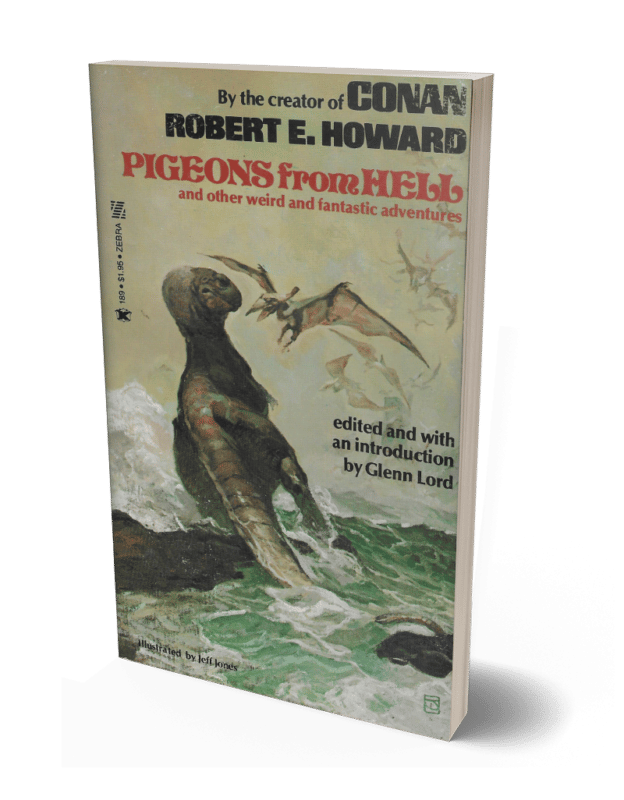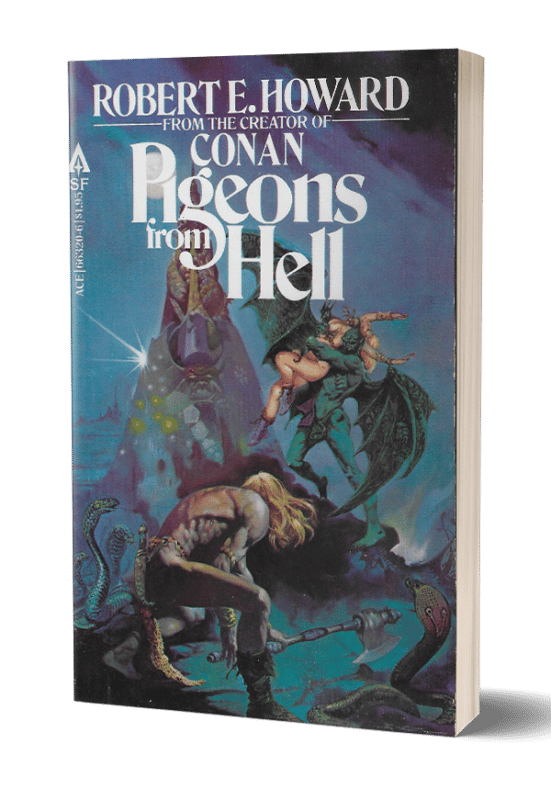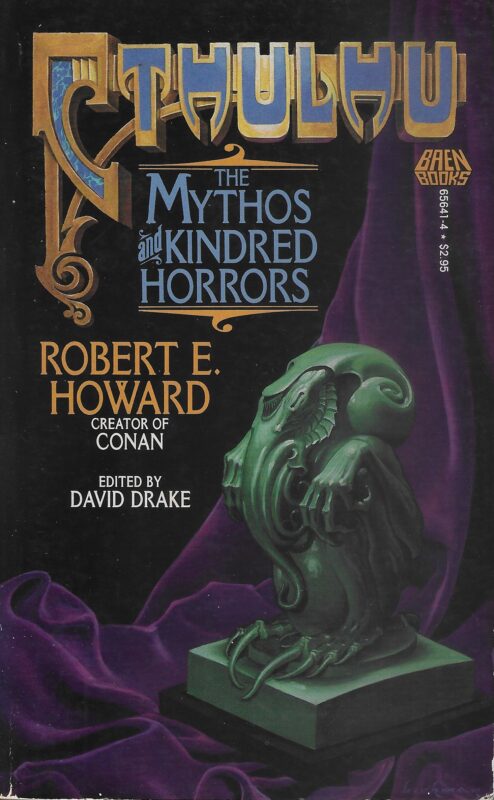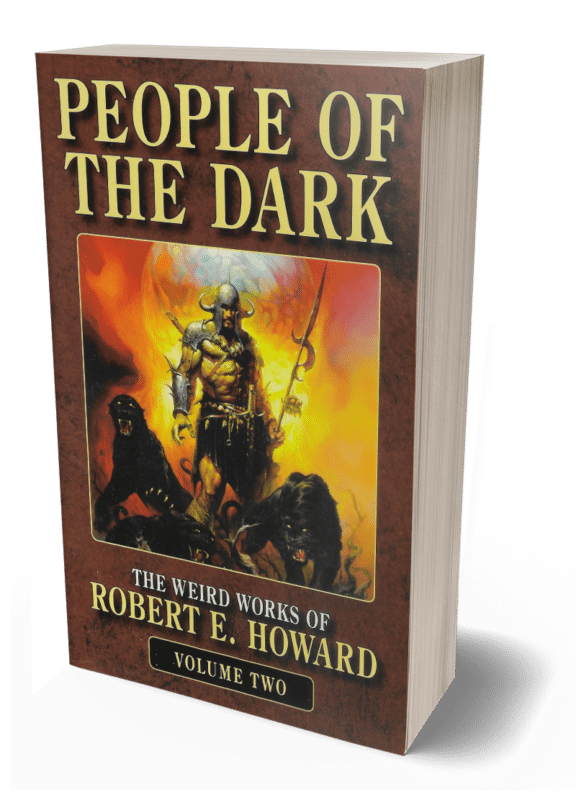Introduction
“People of the Dark”, is considered to be part of the Cthulhu Mythos.
In October 1931, Howard completed the first version of a story titled People of the Dark and sent it to Clayton Publications’ new magazine, Strange Tales of Mystery and Terror, a direct competitor to Weird Tales. Editor Harry Bates liked the story but asked for some rewriting, returning the story on October 29. Howard complied and a few weeks later Bates accepted the story, along with another tale Howard had sent him, The Cairn on the Headland.
People of the Dark is a remembrance/reincarnation story. In this first-person narrative, protagonist John O’Brien tells of re-experiencing an episode in the life of one of his previous incarnations, one “Conan of the Reavers,” a black-haired Gael who swears by the Celtic deity Crom. It is tempting indeed to see in this Conan a direct prototype for his more famous namesake (and in fact some commentators have done so), were it not for the fact that People of the Dark is a first-person remembrance/reincarnation story, while the Conan stories are not.
From the letters:
On October 29, 1931, Howard received a letter from Harry Bates, editor of Soldier and Fortune, Astounding Stories and Strange Tales (The Clayton Magazines, Inc.):
Dear Mr. Howard:
The originality of your story, “The People of the Dark,” appeals to me. I liked it better than anything of yours I have yet seen.
But I feel it will be much improved if altered. Being a short story, it should not be told in chapters. Asterisks may mark important breaks.
The chief fault that I found in the story was that there was too much fighting and chasing and maneuvering within the body of the story – say, from around page 7 to page 18. I feel that this could be cut by one-third; possibly, in skillful hands, by one-half. Too much of this fighting, physical action spoils the rounded reincarnation effect which is the chief merit of the piece. And such prolonged bloody physical action does not go well in a weird story, anyway. I am not suggesting that you change the quality and nature of the conflict in the body of the story, but only its length.
How about it? If you care to cut this yarn I will be glad to see it again. I cannot promise you now that it will be bought, for Mr. Clayton reads and decides on all stories with me. However, we usually agree pretty closely.Sincerly yours,
Harry Bates, Editor
SOLDIERS OF FORTUNE
ASTOUNDING STORIES
STRANGE TALES
In a letter (#184) to Tevis Clyde Smith, ca. November 1931 we learn about the rewrite mentioned above:
Just before I left Cross Plains, work descended on me in large quantities. A novelet returned from Street & Smith, requesting that I alter it — i.e., eliminate the saloon and speakeasy setting. My hero was a bouncer in a tough waterfront bar. I made him a cook in a hamburger stand. Also a lengthish yarn from Clayton, requesting me to cut down the action, which they said was out of place in a tale of that nature. I acceded to both requests, practically rewriting the stories, at least once, some parts more, and wrote a Costigan yarn before I went all to pieces. I feel that my revised jobs will be turned down because I sent them off without corrections, without even reading them over for mistakes. When I finished them, I’d been working so long and so hard I wasn’t in any shape to hunt for mistakes. I tried to read the stuff over, and the sentences didn’t make sense to me.
The Street & Smith story mentioned is “Fighting Nerves“.
In a letter (#189) written to HPL circa January 1932, he mentions the story at the end:
P.S. I almost forgot to tell you that I finally made Clayton’s Strange Tales with a yarn called, “The People of the Dark” a tale of reincarnation, pre-Roman Britain, Mongoloid aborigines, yellow-haired Britons, Irish pirates, and anything else I could lug in; I hope you’ve also made this market, and certainly, no weird magazine is complete without your magnificent tales.
Howard was pleased with what the Claytons paid which is mentioned in a letter (#191) to Tevis Clyde Smith, circa February 1932:
Oh, yes; I finally made Claytons’. I sold them a couple of yarns in a row, and while they kept me waiting awhile for the dough, they paid well when they did pay — $134 for one, and $144 for the other. Short stories too. I hope to gosh I can sell them a long novelet.
The first one is “People of the Dark” and the second one is “The Cairn on the Headland”.
From a letter (#195) to Tevis Clyde Smith, circa March 1932:
Glad you liked the Roof business and the Sowers stuff I’ve had quite a few praises on the Sowers thing, but don’t know whether they’ll get into the Souk. Likely not. Those yarns I sold Clayton were to their Strange Tales.
The “Roof business” is “The Thing on the Roof”, and the “Sowers stuff” is “The Sowers of Thunder”. The Souk is the letters column of Oriental Stories and the stories sold to Clayton are as mentioned earlier: “People of the Dark” and “The Cairn on the Headland“.
In another letter (#206) to Tevis Clyde Smith, circa May 1932, we learn:
By the way, a friend of mine in Marlin wrote Bates, boosting my “People of the Dark”, and he wrote her telling her that he guessed she could consider me as a regular now — I hope he remembers that, and holds to it. God knows I need the money. Markets are cracking every day. The depression is beginning to lick the wood-pulps.
The friend mentioned was Mrs. F.M. Torbett, of Marlin, the mother of Howard’s friend Thurston Torbett.
And after receiving a letter from Lovecraft, Howard replies in a letter (#208) on May 24, 1932:
Thank you very much for your comments on “People of the Dark” and “The Horror from the Mound.” Your remarks concerning the latter story especially encourages me. I’d begun to fear it was a complete wash-out, seeing that Bates originally rejected it, and some of my friends weren’t much impressed with it. But your kind comments revive my confidence. Please extend my heartiest thanks, also, to Mr. Cook and Mr. Munn, both gentlemen for whose literary talents I have the sincerest regard. I fear my demoniac Black Book scarcely deserves Mr. Munn’s high compliments.
The story
The story begins with John O’Brien, the narrator, entering a dark, eerie forest, with the intent to kill his rival, Richard Brent, over the love of Eleanor Bland. O’Brien falls and hits his head in Dagon’s Cave, leading to a vivid recollection of a past life as Conan, a Gaelic reaver.
In his past life, Conan pursues a British girl, Tamera, into a cavern, followed by her lover, Vertorix. Inside the cave, they encounter the grotesque and ancient Children of the Night, remnants of an aboriginal race. These beings capture Tamera and Vertorix, planning to sacrifice them on a sinister altar. Conan, though initially an enemy, joins forces with Vertorix to save Tamera.
The trio attempts to escape through the cavern’s labyrinthine tunnels, battling the monstrous creatures. Eventually, they find themselves trapped on a ledge above a raging river. As the Children of the Night close in, Tamera and Vertorix choose to jump into the river together, preferring death over capture.
Back in the present, O’Brien awakens in the cave, realizing the cavern’s historical significance and his connection to its past. He discovers that the entrance to the hidden tunnels is blocked but manages to break through. Exploring the caverns, he relives Conan’s memories, encountering remnants of the ancient race’s presence.
The story culminates as O’Brien witnesses Brent and Eleanor, trapped on a ledge by the last surviving creature of the Children of the Night. He shoots the creature, saving them and resolving his past life’s unfinished business. The story concludes with O’Brien feeling a sense of closure and peace, accepting Eleanor’s love for Brent.
Characters
- John O’Brien/Conan of the reavers: The narrator, initially intent on murder, who experiences a past life as Conan, a Gaelic reaver.
- Richard Brent: O’Brien’s rival, the subject of his murderous intent, later revealed as a lover of Eleanor Bland in both past and present.
- Eleanor Bland/Tamera: The woman both O’Brien and Brent love; in the past life, she is Tamera, loved by both Conan and Vertorix.
- Vertorix: A Briton warrior and Tamera’s lover in the past life, who joins forces with Conan to battle the Children of the Night.
- The Children of the Night: An ancient, grotesque race dwelling in the caverns, remnants of a primitive aboriginal race.
Published in:
Click on the flipbook above to read it all.
Published in:
- STRANGE TALES OF MYSTERY AND TERROR Volume 2 Number 2, Clayton Magazines Inc., June 1932
- THE DARK MAN AND OTHERS, Arkham House, 1963
- THE DARK MAN AND OTHERS, Lancer, 1972 (n.d., 95 cents)
- ミステリマガジン1973年11月( MISUTERIMAGAJIN 1973 NEN 11 GATSU) (MYSTERY MAGAZINE NOVEMBER 1973), Hayakawa Publishing Corporation , November 1973 (Japanese)
- THE SAVAGE SWORD OF CONAN VOLUME 1 NUMBER 6, Marvel Comics, June 1975 (graphic adaptation)
- STRANGE TALES OF MYSTERY & TERROR, Odyssey Publications, 1976
- PIGEONS FROM HELL, Zebra, June 1976
- SAVAGE SWORD OF CONAN #6, Marvel, du
- TERRA FANTASY #55: GESPENSTER DER VERGANGENHEIT, Erich Pabel Verlag, December 1978 (German)
- MARVEL TREASURY EDITION #19, Marvel Comics, 1978 (graphic adaptation featuring Conan)
- THE DARK MAN OMNIBUS, Volume 2, Panther, 1979
- PIGEONS FROM HELL, Ace, 1979
- TERRA FANTASY #55: GESPENSTER DER VERGANGENHEIT, Erich Pabel Verlag, 1981 (German, 2nd printing)
- CTHULHU THE MYTHOS AND KINDRED HORRORS, Baen, May 1987
- LE PACTE NOIR, NeO, 1st Quarter 1979 (French)
- LE PACTE NOIR, Marabout, January 1981 (French)
- EL VALLE DEL GUSANO, Ediciones Martinez Roca, 1986 (Spanish)
- LE PACTE NOIR, NeO, November 1987 (French, 2nd printing)
- CTHULHU THE MYTHOS AND KINDRED HORRORS, Baen, 2nd, 1989
- LE PACTE NOIR 2, Fleuve Noir, November 1991 (French)
- 黒の碑(いしぶみ) (KURO NO ISHIBUMI), Sōgen Suiri Bunko, December 1991 (1st edition)(Japanese)
- CTHULHU THE MYTHOS AND KINDRED HORRORS, Baen, 3rd, 1992
- WYSŁAŃCY WALHALLI, Wydawnictwo Arka, 1992 (Polish)
- KADOTUKSEN KUILU, WSOY, 1993 (Finnish)
- OMBRE DAL TEMPO, Fanucci Editore, August 1994 (Italian)
- AZ ÉJSZAKA GYERMEKEI, Cherubion Könyvkiadó, 1997 (Hungarian)
- THE NIGHT OF THE WOLF, North-West, 1997 (Russian)
- 黒の碑(いしぶみ) (KURO NO ISHIBUMI), Sōgen Suiri Bunko, August 2000 (2nd printing)(Japanese)
- KILIÇ VE BÜYÜ, İthaki Yayınları, 2000 (Turkish)
- NAMELESS CULTS, Chaosium, December 2001
- ROBERT E. HOWARD AND WEIRD TALES #4, Dennis McHaney, December 2002 [Distributed in REHUPA #178]
- PIMEDUSE RAHVAS, Fantaasia, 2002 (Estonian)
- PULP REPLICA: STRANGE TALES #5, Girasol Collectables, October 2003
- ROBERT E. HOWARD’S STRANGE TALES, Dennis McHaney, January 2005
- PEOPLE OF THE DARK, Wildside Press, July 2005
- ROBERT E. HOWARD’S STRANGE TALES, Dennis McHaney, December 2005
- PEOPLE OF THE DARK, Wildside Press, June 2006
- THE EXOTIC WRITINGS OF ROBERT E. HOWARD, Girasol Collectables, October 2006
- THE HAUNTER OF THE RING & OTHER TALES, Wordsworth Editions, September 2007
- PEOPLE OF THE DARK, Cosmos Books, November 2007
- PEOPLE OF THE DARK, AND SPEAR AND FANG, Dodo Press, February 2008
- THE HAUNTER OF THE RING & OTHER TALES, Wordsworth Editions, 2008
- PEOPLE OF THE DARK: THE WEIRD WORKS OF ROBERT E. HOWARD VOLUME 2, Audio Realms, June 2008 (audio)
- THE HORROR STORIES OF ROBERT E. HOWARD, Del Rey, October 2008
- BRAN MAK MORN, L’INTÉGRALE, Bragelonne, November 2009 (French)
- PEOPLE OF THE DARK AND OTHER HORROR STORIES, Halcyon Press, Ltd., January 2010
- THE HORROR STORIES OF ROBERT E. HOWARD, Tantor Media, Inc., March 2010 (audio)
- VOLK DER FINSTERNIS, Festa Verlag, March 2010 (German)
- THE ROBERT E. HOWARD OMNIBUS: 99 COLLECTED STORIES, Halcyon Press, Ltd., May 2010
- KROK ZE TMY, Albatros Media, 2010 (Czech)
- THE HORROR STORIES OF ROBERT E. HOWARD, Subterranean Press, March 2011
- DAYS OF HIGH ADVENTURE, Schlock! Publications, March 2012 (UK)
- KULL OF ATLANTIS AND OTHER STORIES, Jame-Books, August 2012
- BRAN MAK MORN ÉS A PIKTEK, Delta Vision Kft., August 2012 (Hungarian)
- BRAN MAK MORN ÉS A PIKTEK, Delta Vision Kft., November 2012 (Hungarian)
- KRÓLESTWO CIENI I INNE OPOWIADANIA Z MITOLOGII CTHULHU, Agharta, January 2013 (Polish)
- WEIRD TALES: 101 WEIRD, STRANGE, AND SUPERNATURAL STORIES VOLUME 6, Civitas Media, January 2013
- ROBERT E. HOWARD’S COLLECTED WORKS, Jame-Books, February 2013
- WEIRD TALES: 101 WEIRD, STRANGE, AND SUPERNATURAL STORIES VOLUME 6, Civitas Media, May 2013
- CULTOS INOMINÁVEIS, Saída de Emergência, February 2014 (Portuguese)
- CULTOS INOMINÁVEIS, Saída de Emergência, March 2014 (Portuguese)
- THE FEARSOME TOUCH OF DEATH, Ulwencreutz Media, July 2014
- ROBERT E. HOWARD SHORT STORIES & NOVELLAS, Business and Leadership Publishing, July 2014
- SWORDS OF THE NORTH, REH Foundation Press, December 2014
- I FIGLI DELLA NOTTE. RACCONTI DELL’ORRORE VOLUME 1, Arnoldo Mondadori Editore, March 2015 (Italian)
- DER KAMPF DER ASEN, Uksak E-Books, April 2016 (German)
- O MUNDO SOMBRIO: HISTÓRIAS DOS MITOS DE CTHULHU, Editora Clock Tower, March 2016 (Portuguese)
- ALMURIC AND OTHER FANTASIES, Ozymandias Press, July 2016
- БЕЗЫМЯННЫЕ КУЛЬТЫ: МИФЫ КТУЛХУ И ДРУГИЕ ИСТОРИИ УЖАСА (NAMELESS CULTS: CTHULHU MYTHOS AND OTHER HORROR STORIES), AST, August 2016 (Russian)
- ALMURIC AND OTHER FANTASIES, Jovian Press, October 2016
- PEOPLE OF THE DARK, Jovian Press, November 2016
- ALMURIC AND OTHER FANTASIES, Zero-Sum Press, February 2017
- PULP FACSIMILE: STRANGE TALES V2N2, Wildside Press, May 2017
- PULP FACSIMILE: STRANGE TALES V2N2, Fiction House Press, April 2019
- GLI INFINITI RITORNI. STORIE E SCRITTI SULLA REINCARNAZIONE, Elara, July 2020 (Italian)
- RATTLE OF BONES & OTHER TERRIFYING TALES, Clover Press, July 2020
- THE CTHULHU STORIES OF ROBERT E. HOWARD, WordFire Press, September 2020
- LES GUERRIERS DU VALHALLA, Le Livre de Poche, November 2020 (French)
- PULP FACSIMILE: STRANGE TALES V2N2, Adventure House, November 2020
- I RACCONTI RITROVATI, Independently Published, December 2021 (Italian)
Sources and credits
Introduction from Hyborian Genesis, by Patrice Louinet.















